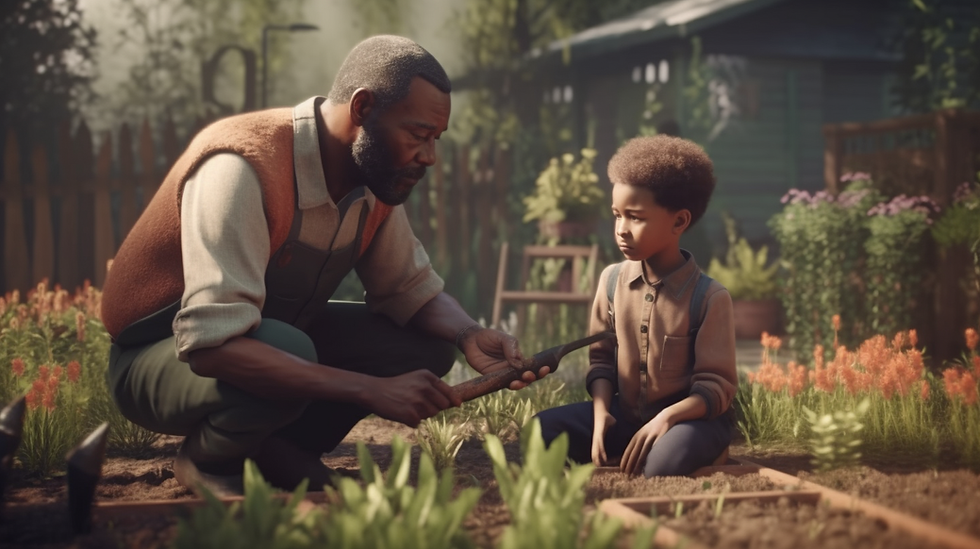Gardening for All Ages - Perks for Gardeners of Any Generation
- Gardening with DaXman

- Oct 26, 2023
- 4 min read

Intergenerational gardening offers an opportunity for the young and old to collaborate to their collective advantage. It provides a platform for kids to gain knowledge, while also allowing seniors to become mentors and teachers as well as have a pleasant time with one another.
Let's take a look at Intergenerational Gardening, shall we? It's all about bringing different generations together through gardening.
Gardening across generations is an activity that involves cultivating plants in a shared space. It is a way for different generations to come together, interact, and learn from one another. Through intergenerational gardening, individuals of all ages can benefit from the therapeutic and educational aspects of gardening. Gardening together with two or more generations is a great concept. Generally, it involves seniors, who have a lot of gardening knowledge and sometimes experience mentoring kids.
Many organizations arrange intergenerational gardening activities. Senior residences and assisted living centers may begin a garden and invite the grandchildren or offspring of the staff to help. Additionally, local garden clubs, community centers, and community gardens are becoming increasingly popular places for intergenerational activities. On occasion, elderly individuals may set up local organizations just to pass on their knowledge to the younger people in the vicinity. They could offer their aptitude in schools or initiate a communal garden.
Why Gardening is Awesome for All Ages
The purpose of an intergenerational garden is to enable elderly people to educate youngsters in gardening techniques, however, there are several other advantages that can be gleaned from this type of arrangement. These benefits are beneficial to both the younger and senior generations.
For Children
The experience that elderly people have accrued in gardening over the years can be of great advantage to young children. Not only do they learn useful skills, but there are other benefits too. These include:
Possibility of spending more quality time outdoors and with nature, as well as having access to nutritious meals
Obtaining a sense of accountability for plants and the environment around them
Boosting self-worth from gaining new skills and being proud of their accomplishments
Gaining appreciation for elderly people and forming positive views on growing old
Establishing strong connections with the elderly in their locality
Becoming knowledgeable on where their food is sourced from
One way to avoid plagiarism is to alter the structure of the text without changing its context or the semantic meaning. This can be accomplished by rephrasing sentences, substituting words, and rearranging the order of the words.
It can be argued that the Internet has had an immense impact on our lives. From communication to access to information, this technology has revolutionized the way we interact with one another and the world around us. The reach of the Internet is far and wide and it has allowed us to bridge geographical boundaries, connect with people from different cultures, and stay up-to-date with the latest news and trends. Its influence on our lives is undeniable and its impact will continue to grow as technology advances.
For Elderly People
Gardening is a great way for seniors to share their wisdom and talents with younger generations. It is also advantageous to them, as it provides:
Experiencing a fulfilling and gratifying pastime
Passing along the individual insights and techniques they've picked up in gardening in the course of time
Constructing substantial connections that may extend outside of the garden
Seeing the newer generations and the struggles they confront
An opportunity to go outdoors and become more physically fit
The way of avoiding plagiarism is by altering the structure of the writing while still keeping the same context and meaning. This is done by rearranging the words and sentences, as well as changing some of the language used. It is important to ensure that the original author's ideas are still expressed, just in a different form. The idea of eliminating plagiarism can be accomplished by altering the composition of the text while still maintaining the meaning and context. This can be done without altering the markdown formatting.
Getting Started with an Intergenerational Garden: Handy Tips and Tricks
It is evident that gardening provides numerous advantages for people of all ages, but how should one start? A great way to begin is to join two compatible groups, such as a preschool and a local garden club, or an elementary school and a senior center. In order to move forward, your group must locate a suitable area for your garden. This could be situated at a senior living facility, a school, or through the assistance of a local government agency or business who could provide a public space. For more information, refer to Gardening Know How.
A team should be formed for the project, containing both seniors and children. This team could consist of the seniors, staff from the senior center, teachers, administrators, or the parents of the children. This group should then come together to agree upon the desired objectives and standards of the garden.
Once you possess a garden, devise a strategy for what to cultivate and a timetable of gatherings and undertakings for both groups to work together. Educators can help the senior citizens design tasks that are suitable for the young ones. As an example, preschoolers could construct crafts or sow seeds, while older elementary students could be prepared to participate in more intricate gardening activities.
Creating a garden that brings together seniors and children, allowing them to learn from and inspire each other, may require some time and effort. However, the rewards are definitely worth it! It is important to carefully plan and have the right individuals on board to help bring this wonderful intergenerational garden to life.





Comments